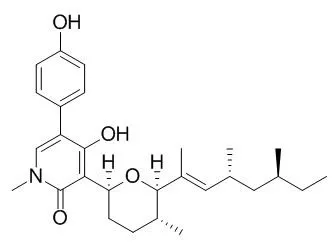| Description: |
Sambutoxin, a new mycotoxin produced by toxic Fusarium isolates obtained from rotted potato tubers, it can cause toxic effects in rats, including body weight loss, feed refusal, hemorrhage in the stomach and intestines, and, finally, death when rats were fed diets supplemented with 0.05 and 0.1% sambutoxin. Sambutoxin has in vitro cytotoxicity against various human and murine tumor cells and values of sambutoxin ranged from 46.2 to 1,425.6 ng/ml. It inhibits rabbit platelet aggregation, which may be party due to the decrease of ATP release.
|
| In vivo: |
| Appl Environ Microbiol. 1994 Dec;60(12):4380-6. | | Sambutoxin, a new mycotoxin produced by toxic Fusarium isolates obtained from rotted potato tubers.[Pubmed: 7811078] |
Ninety-nine isolates of Fusarium species were obtained from rotted potato tubers from various parts of Korea.
METHODS AND RESULTS:
Of these isolates, 80 were identified as Fusarium oxysporum, F. solani, or F. sambucinum. The isolates of these species were grown on autoclaved wheat grains and examined for toxicity in a rat-feeding test. A total of 8 of 57 F. oxysporum isolates, 3 of 14 F. solani isolates, and 5 of 9 F. sambucinum isolates caused the death of the rats. Of the 16 toxic isolates, 1 isolate of F. oxysporum produced a substantial amount of moniliformin, which could account for its toxicity. None of the other 15 isolates produced trichothecenes, moniliformin, fusarochromanone, fumonisin B1, or wortmannin. F. sambucinum PZF-4 produced an unknown toxin in wheat culture. This new toxin, given the trivial name Sambutoxin, caused toxic effects in rats, including body weight loss, feed refusal, hemorrhage in the stomach and intestines, and, finally, death when rats were fed diets supplemented with 0.05 and 0.1% Sambutoxin. The toxin was also toxic to chicken embryos, and the 50% lethal concentration was 29.6 micrograms per egg. Sambutoxin formed as white crystals that turned purple when combined with reagents such as sulfuric acid and p-anisaldehyde. It exhibited a green color immediately after treatment with potassium ferricyanide-ferric chloride. Its UV spectrum had absorption maxima at 213, 233, and 254 nm, and its infrared spectrum showed an amide group at 1,650 and 1,560 cm-1 and a hydroxy group at 3,185 cm-1.
CONCLUSIONS:
Mass spectrometry showed that the molecular weight of the toxin was 453 and the molecular formula was C28H39NO4. |
|






 Cell. 2018 Jan 11;172(1-2):249-261.e12. doi: 10.1016/j.cell.2017.12.019.IF=36.216(2019)
Cell. 2018 Jan 11;172(1-2):249-261.e12. doi: 10.1016/j.cell.2017.12.019.IF=36.216(2019) Cell Metab. 2020 Mar 3;31(3):534-548.e5. doi: 10.1016/j.cmet.2020.01.002.IF=22.415(2019)
Cell Metab. 2020 Mar 3;31(3):534-548.e5. doi: 10.1016/j.cmet.2020.01.002.IF=22.415(2019) Mol Cell. 2017 Nov 16;68(4):673-685.e6. doi: 10.1016/j.molcel.2017.10.022.IF=14.548(2019)
Mol Cell. 2017 Nov 16;68(4):673-685.e6. doi: 10.1016/j.molcel.2017.10.022.IF=14.548(2019)